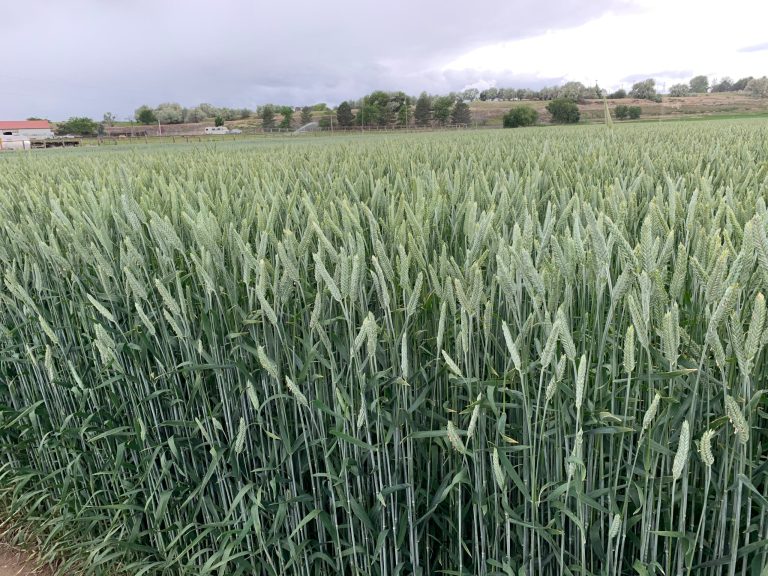Many livestock farmers are growing TriCal Superior Forage for its high tonnage and superior feed quality. But they’re quickly realizing those aren’t its only benefits.
With its quick-producing ground cover and fibrous root system, TriCal Superior Forage helps capture water, protect the soil and recycle nutrients. Thanks to its winter hardiness, it serves the soil at a time when the ground is usually bare and soil microbes are hungry for living roots. Given its versatility to work as both a cover crop and cash crop, every farmer can benefit from its regenerative ag qualities while also protecting their bottom lines.
Capturing Water and Maximizing Its Use
One of the biggest regenerative ag benefits of TriCal Superior forage is its ability to capture water.
“It has a fibrous root system,” says Small Grains Research Director Racey Padilla. “Most of the time this tends to be better for filtrating water through the soil than something that has a taproot.”
It’s also bred for aboveground biomass, Racey adds, and that good ground coverage allows for greater water absorption.
In addition to collecting water, triticale also doesn’t use as much of it as other crops, a further benefit for growers in drier climates. Racey is seeing farmers in the Ogallala Aquifer opt for triticale because it’s more drought tolerant than corn.
Triticale is also more drought tolerant than corn, which makes it a great fit for farmers in locations struggling with water availability, such as those on the Ogallala Aquifer.
“You’re still getting really high tonnages and quality feed, but you’re doing it with about a third less water for the year,” Racey says.
Rick Pearson can attest to triticale’s drought resistance. Based in Buhl, Idaho, Rick is a seed producer for TriCal Superior Forage and says the southern part of the state just recently dealt with a water shortage. Farmers were concerned there wasn’t enough water to grow the crops they normally would, so they decided to switch to triticale.
“They still got the tonnage, even with less water,” Rick says.

Protecting Soil and Pulling Nutrients
Rick has been producing for TriCal Superior Forage for several years, and in that time he’s witnessed its regenerative ag benefits, both on his farm and on neighboring dairies.
In addition to growing triticale for seed, Rick also grows wheat for seed, silage and/or grain corn, alfalfa, and potatoes. He plants a winter triticale variety in the fall and harvests it the following August, and he’s noticed that because of its ground coverage he doesn’t see as much wind erosion as he does when he’s growing potatoes or corn. For his neighboring dairy farmers, including triticale in their rotation means the ground has living roots in it virtually year-round, because they typically double-crop it with their corn.
Rick says most of the dairies are using triticale because of its ability to pull nutrients from the manure they apply. Racey explains that while it scavenges for nitrogen very well, triticale also pulls phosphorus out of the soil, which is a big benefit for dairies and livestock farmers.
“They have a manure management plan they have to do and the only way to get rid of the manure is to use it as fertilizer,” Racey says. “Phosphorus is not mobile in the soil, so wherever it lands, that’s where it stays. So triticale, with its fibrous root system, is really good about pulling a lot of the phosphorus out of the soil.”
In fact, Racey recently talked to a dairy in Georgia that did some soil testing to make sure they were removing the nutrients for their manure management plan, and they were impressed with how much phosphorus and nitrogen the triticale was able to pull out of the ground.

A Money-Making Cover Crop
Because triticale is a high-producing, high-quality forage crop, even growers who don’t have livestock have the opportunity to benefit from its regenerative ag qualities without incurring the typical cost of a cover crop.
Instead of growing a cover crop that either winterkills or is terminated, farmers can use triticale almost as another cash crop by selling it to local livestock operations. They can either cut it and sell it as a feed, or find a local livestock owner who is interested in bringing their livestock to graze on it. Rick points out that grazing the triticale would also provide the grower the added benefit of capturing nutrients from the animal.
Racey says that small grain silage is bringing in anywhere from $60-$90 a ton, so if a farmer can grow 4-6 tons, that can offset the cost of growing triticale as a cover crop.
The key to capturing the benefits of triticale as both a cash and cover crop is to select a high-quality, high-producing variety. Which is why TriCal Superior Forage is a perfect fit for farmers who want to improve their soils and benefit their bottom lines.
